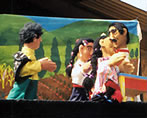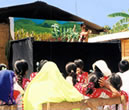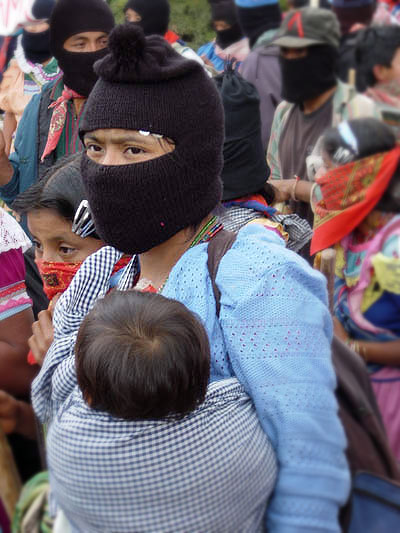
2002
02/01/2003ANALYSIS: Resistance and autonomy, the creation of the zapatista juntas of good government
29/08/2003Since 1996 Northern Chiapas (in particular the lower zone of Tila) has become one of the most conflictive regions of the state. In this area, there has been countless missing persons and deaths, an even larger number of political prisoners, attacks, and displacements of entire communities.
 SIPAZ began visiting the zone together with other Chiapanecan NGO’s to observe if there were any acts of violence and survey the condition of human rights there. The project was named Northern Station for distention and reconciliation. Unfortunatly observers were quickly assumed to be Zapatistas and/or members of the PRD party by the Government’s party, the army, and the Peace and Justice armed group; on two occasions the members of the Northern Station were attacked, thus, we decided to leave that zone.
SIPAZ began visiting the zone together with other Chiapanecan NGO’s to observe if there were any acts of violence and survey the condition of human rights there. The project was named Northern Station for distention and reconciliation. Unfortunatly observers were quickly assumed to be Zapatistas and/or members of the PRD party by the Government’s party, the army, and the Peace and Justice armed group; on two occasions the members of the Northern Station were attacked, thus, we decided to leave that zone.
In 1999 the SIPAZ team began again to have continuous presence in Northern Chiapas. Since then, we have periodically visited over twenty communities in the Tila zone where there has been intense conflict, in addition to a few other communities in Sabanilla.
The purpose of an international presence in these areas of conflict is to discourage any violence, as well as to create and maintain a peaceful atmosphere in which dialogue and tolerance can be promoted between opposing groups. To attain the latter, SIPAZ continues to seek the development of relationships among all the acting parties.
For some time, we have been discussing the possibility to enrich the accompaniment work with other activities, such as puppets shows and workshops promoting the solution of conflicts in a peaceful manner.
We were given the opportunity when we received an invitation from Alianza Cívica-Chiapas to participate in the puppet project last year. Since December we have worked in presenting these shows in various places, and sometimes these presentations have been combined with conflict transformation workshops, plus forums and other discussions.
One of the SIPAZ volunteers in Chiapas who has collaborated since 1999, gave the following account:
 “In February 2003 we made our first tour of puppets through Northern Chiapas. There were five of us (two with SIPAZ and three with Alianza Cívica) and we had many questions that still needed to be answered: How would people of the communities would receive us? Who should be making the calls, considering the political and religious divisions existing in the zone? Would they be able to understand us given that we could not speak their Ch’ol language? How would we resolve any technical issues…? Working for peace requires that we evaluate and take advantage of the existing diversity so that communitarian life is improved and division is avoided. Our group is an interesting example of the possibility for the coexistance of diverse people due to the fact that it was integrated by people of Chiapas, Northern Mexico, the U.S.A., Spain, and Germany. Men and women from 24 to 42 years old, each one with his/her stories, experiences, wishes and needs. The intensity of the journey helped us to grow closer and also to better know ourselves.
“In February 2003 we made our first tour of puppets through Northern Chiapas. There were five of us (two with SIPAZ and three with Alianza Cívica) and we had many questions that still needed to be answered: How would people of the communities would receive us? Who should be making the calls, considering the political and religious divisions existing in the zone? Would they be able to understand us given that we could not speak their Ch’ol language? How would we resolve any technical issues…? Working for peace requires that we evaluate and take advantage of the existing diversity so that communitarian life is improved and division is avoided. Our group is an interesting example of the possibility for the coexistance of diverse people due to the fact that it was integrated by people of Chiapas, Northern Mexico, the U.S.A., Spain, and Germany. Men and women from 24 to 42 years old, each one with his/her stories, experiences, wishes and needs. The intensity of the journey helped us to grow closer and also to better know ourselves.
The journey lasted eight days. We presented puppet shows to nine communities within two different municipalities, the attendance ranging from 30 into the hundreds. There is no doubt that the children were the most enthusiastic participants.
Of course it was not always easy. At times we were received in the market place with welcome signs, but there were difficult days as well. Once we had to perform under the rain while the public stood with umbrellas until the end.
Once, on a Sunday, we coincided with the market day in the El Limar downtown where people of various communities were gathered. This is where a peace and reconciliation accord was signed by the Catholics who had been prosecuted for their sympathy with the EZLN, so that they could enter their church that had been occupied by a Paz y Justicia (PyJ) group since years before. Also, one of the main PyJ leaders had been held in prison for over a year, who, according to the testimony given by many, is responsible for the violence prevailing in the zone for years. After the puppet show, we could hear some voices stating: “This is how our conflicts started in here” “May God wish that this message reaches the hearts of our people”.
We arrived to the Shucjá community, a place where many people who had been expelled from their homes now live. Some of them, who have been negotiating their return, spoke out about their fears and hopes to us. One of them asked: “Why don’t you come with us when we go back?” One group is returning to their own lands and people of other communities are helping them with the building of their new homes.
So we continued our journey through irregular land ways, some of us walking, others in the vehicle that was piled up with the theater, bags with puppets, the scenery, and our luggage.
We presented a puppet play in the community school, and according to the testimony of some, the public had an active participation in the conflict, and this is where we were only able to make a few contacts just last year. There, only the children and some mothers attended.
From there, we arrived in Jolnixtie, a divided community. In 1996 there was an outbreak of violence and, subsequently, the displacement of inhabitants. Though later some of the people who had been displaced came back, but without reconciliation. Nevertheless, these people are trying to unite again. The school in Jolnixtie is the most neutral place in the community. When children arrive they cry for ¡Puppets!. Both children and teachers helped to set the theater and provide us with microphones. In the afternoon, we invited the whole community. We had children coming but with many adults as well. Those who came closer were at least able to listen, because the sound was so loud it was impossible not to pay attention. The catechist helped with the interpretation and reflection in the Ch’ol language. Some protestants arrived also, as well as the various political forces.
The following presentations were made in Huanal, a cattle breeding community that lost all of its cattle during the conflict when they were attacked by their zone’s neighbors. But, from what they have heard, it was the military and the policemen who finally gave account of the cattle. Their history is very much like one of our plays in which two rabbits were fighting for the same carrots meanwhile mice are taking advantage of the situation and stealing the carrots. The teachers helped us make the children reflect and respond. In the afternoon the whole community came, because it was dark some of the attendants lit the theater with hand lanterns. The school director and a teacher helped us in encouraging people to reflect: both teachers and attendants made pronouncements that reflect that they belong to opposite political current.
Early in the morning we continued walking to Obregon. On our way we found the peasants going to do their work; they learned about our visit and were expecting us with joy. We presented two shows: one with kids and the other with the whole community. Several people expressed themselves in the Ch’ol language, and at night we met in a classroom at the school to continue talking on the main problems that afflict the community. Men and women expressed their worries about the government’s economic policy and the effects they have in their communities. They were especially critical of the Puebla-Panama Plan. The community is divided into different regions and political parties, but their religious and political leaders gathered and were able to subscribe a non-aggression pact to avoid more violent events in the community. During the most violent time of the conflict they received refugees from other communities.
When we were there, away from any mechanical workshops or gas stations, the car’s battery broke down. Fortunately there was someone eager to help us who provided us with the battery of his van so that we could travel up to Salto de Agua, the closest place where we could get a battery.
 We went back to Tila’s lower zone. We were invited to celebrate the anniversary of the returning of formerly expelled inhabitants at Cruz Palenque. One morning in August 1997, some armed men had come and assulted the dwellings of those who were not cooperating with the government. One man was murdered and the rest were able to leave with their families and find refuge in another community. The inhabitants that were members of the PyJ were encouraged to steal the cattle of those who had been expelled. Later on, they realized that they had been deceived and attempted the return of those who had been expelled and to reconcile their differences. They are now celebrating the 4th anniversary of their return.
We went back to Tila’s lower zone. We were invited to celebrate the anniversary of the returning of formerly expelled inhabitants at Cruz Palenque. One morning in August 1997, some armed men had come and assulted the dwellings of those who were not cooperating with the government. One man was murdered and the rest were able to leave with their families and find refuge in another community. The inhabitants that were members of the PyJ were encouraged to steal the cattle of those who had been expelled. Later on, they realized that they had been deceived and attempted the return of those who had been expelled and to reconcile their differences. They are now celebrating the 4th anniversary of their return.
Nevertheless, for some the war is still not over. Some members of the community told us that the day before, another murder had taken place. Apparently the victim, that was murdered while in his sowing place, was a member of the PRI party and was participating in the reconciliation process with the curch of Tile. One can sense the stress in the surrounding communities. We were told that some men coming from other PRI controlled communities have been seen lately. There has been many assassinations still waiting to be clarified in these communities, and the victims belong to all groups.
We had one puppet show still pending at Nuevo Limar, a highly divided community that is controlled in its majority by the PRI partisans, and it also has army base. Some persons have confessed they feel threatened again and recommended us not to present the play downtown, as we had initially thought, for fear of reprisals.
We finally decided to present the play in front of their house. Surprisingly, it was with this play that the public had a larger participation. Also, we were able to have the attendance of persons of different political and religious trends. People were grateful for our visit; we could feel how they felt encouraged.
We went back to San Cristobal with a happy heart and willingly to proceed with our puppets tour in other communities.”
Translated by: M.L. Andrade
Mexico City, April 23, 2003

